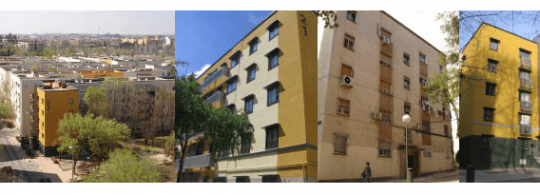
The transformation of Ciudad de los Ángeles, in Madrid’s Villaverde district, is an example of institutional collaboration, participation and consensus with residents. This area, in which refurbishment has been approached from an integral standpoint, is an urban planning model typical of the 1960s, with a design and layout that was very popular in the outskirts of Madrid at the time, consisting of free-standing towers and linear blocks separated by large open spaces.
Prestigious Madrid architects Secundino Zuazo and Manuel Muñoz Monasterio took part in building the first developments. Despite having excellent environmental quality, the district presented a series of deficiencies that led it to be declared an Integrated Refurbishment Area in 2005 for the period 2005-2011 (later extended to 2015), with a view to promoting refurbishment of the buildings and homes, and improving urban infrastructure.
This has now been shown to be a successful approach. Financial backing from all three administrations, coupled with the interest and support of the residents themselves, made this district a laboratory in which a number of residential innovation and refurbishment initiatives have been implemented. The district’s quality and image now serve as an example for professionals, technical experts and even other cities, which visit it in search of a formula for success. In 2013, it received the Award for Best Urban Planning or Refurbishment Project (Premio a La Mejor Actuación Urbanística o de Remodelación Urbana) from Spain’s Association of Real Estate Developers (ASPRIMA).
A two-pronged approach was adopted:
- Building: in general, foundations were deficient (25%), insulation was inadequate in terms of energy saving and efficiency (90%), and 52% of buildings did not have lifts. Furthermore, the original plumbing and electrics were still in place and were obsolete.In respect of the buildings, the criteria for refurbishment and urban renewal focused on improving the performance of the enclosures (through insulation and replacement of woodwork and ironwork), the removal of barriers and improvement of accessibility, structural stability and upgrading of installations to comply with current regulations.
- Urban planning: green areas had deteriorated and there were architectural barriers; there were overhead power lines and obsolete installations, as well as a lack of parking spaces. The focus was on improving mobility, removing architectural barriers, and renewing urban furniture and equipment. A cycle lane was also installed.
The results are highly satisfactory and provide a real, vibrant and clear example that energy refurbishment is worth it—well worth it.
Ciudad de los Ángeles in figures
- 70 buildings were refurbished, containing 1,037 homes;
- Another 357 are in the process of refurbishment;
- The total planned investment is 61.1 million euro;
- Energy sustainability alone accounts for 32% of the allocated budget;
- More than 100,000 m2 of land has been affected;
- 12.9 million euro have been invested so far.






There are no comments yet